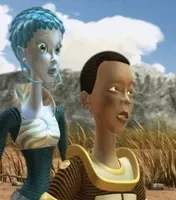Huhu Animation win lucrative six-part US Series
Written by

Last December Huhu Studios won a deal for a six-part series of animated and 3D movies of Bible stories worth NZ $37 million. With a background in plastic manufacturing, including winning the 1978 Export Award for designing bubble wrap packaging, and then later setting up Omega Plastics, the CEO of Huhu Studios, Trevor Yaxley first decided to move into animation in August 1999.
Image: Still from The Future is Wild - Huhu Studios.Last December Huhu Studios won a deal for a six-part series of animated and 3D movies of Bible stories worth NZ $37 million. With a background in plastic manufacturing, including winning the 1978 Export Award for designing bubble wrap packaging, and then later setting up Omega Plastics, the CEO of Huhu Studios, Trevor Yaxley first decided to move into animation in August 1999.
Image: Still from The Future is Wild - Huhu Studios.Yaxley and his wife founded Huhu Studios and began producing a children's animation series based on New Zealand wildlife. Buzz & Poppy soon became a New Zealand icon and Huhu Studios went on to become one of the leading animation studio in New Zealand, now producing world class theatrical animations in partnership with Promenade Pictures in Hollywood. Yaxley is one of the producers of Promenade's animated version of The Ten Commandments.
Can you please give our readers some background on the NZ$37 million deal that Huhu has won for the animated and 3D movies based on Bible stories?
Huhu Studios has quietly been developing over the last eight or nine years. The main focus of that time was the developing of industry relationships and a reputation for being a reliable and trustworthy studio capable of delivering on time, under budget and with exceptional quality. For this deal we have been developing a relationship with Promenade Pictures in Los Angeles. The head of Promenade is Frank Yablans, who started Buena Vista with Roy and Walt Disney and is known as the 'Godfather' of the blockbuster movie, of which The Godfather was the first. Promenade's vision is very similar to Huhu's as we both wish to provide entertainment with a message and stories that inspire.
Who brokered that deal for you and how long has it been in the pipeline?
I brokered the deal and it has come from two years of working together closely with Promenade.
Modern animation often sacrifices atmosphere for high-tech effects, but Huhu's show-reels (particularly Buzz and Poppy) combine refreshingly old-fashioned characterisation with modern techniques. How would you describe Huhu's style?
You have described it better than we could, with old fashioned characterisation combined with modern techniques. We work hard to stay at the forefront of technology because this helps us more effectively express our creativity.
The characterisation of Christianity is always highly political, from Mel Gibson's The Passion of Christ to Martin Scorsese's The Last Temptation of Christ and Ron Howard's The Da Vinci Code. Will this work be a sympathetic counter to those depictions?
Huhu Studios is in many regards different from the major Hollywood studios, in that our values and our work reflects the timeless values of Christianity. These values are largely common to the major religions of the world, including Judaism and Islam (and so we hope is accessible and able to be appreciated for what it shares in common with other religions €” rather than highlighting the differences). We feel our work is less political, in that it reflects the values that we live and operate by every day, and in doing so we hope will be more trusted than some of the other politicised depictions of religious beliefs that have been produced in the last couple of years.
What does animation give to storytelling that live action doesn't?
Animation provides access to the full creative scope of our imagination without the same restriction upon resources that sometimes inhibits live action movies. Being free of these constraints enables a good story to be constructed and effectively communicated. The key, however, is not so much a style €” such as animation €” but the quality of the underlying story and the messages and values communicated within that story.
Computer animation versus cell animation: what are the pros and cons?
Both have their qualities, but 3D gives a great real life feel. It also gives you more options for animating. The computer animation pre-production time is longer for 3D. However, although it takes longer to build an asset, once you have them you can build a library that can be re-used in the future. Finally you also have far more control of camera, lights, angles and a great depth of field which you can't get in 2D.
Huhu's website mentions attractive NZ$ exchange rates, which enable you to produce "high-quality animation for remarkable budgets". Do you foresee a time when Huhu won't be able to differentiate itself on price?
No, because if we link with the correct partners internationally, we will always remain best value for money. Further, we invest significantly in creating our own technology and getting ahead on the technology curve.
Which current innovation is likely to have the biggest impact on animation in the future?
Cost-to-quality ratio: the ability to deliver more for less becomes increasingly important as the field develops and more movies are released more regularly, which is very much the current trend.
What is Huhu's x-factor?
Its efficient pipeline and strong relationships, right through the supply chain and its ability to draw and develop great people. To this end, we have started our own animation school through Lifeway College, which is in our view NZ's leading animation school, and each year we employ a significant number of graduates from the two-year diploma programme.
Interview by Chris Bell
19/1/07